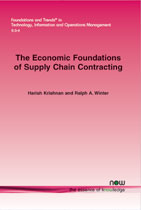The Economic Foundations of Supply Chain Contracting
By Harish Krishnan, Sauder School of Business, University of British Columbia, Canada, harish.krishnan@sauder.ubc.ca | Ralph A. Winter, Sauder School of Business, University of British Columbia, Canada, ralph.winter@sauder.ubc.ca
Abstract
Why do supply chain contracts take the forms that they do? Which contracts should firms adopt to coordinate incentives along a supply chain? This monograph synthesizes the theory of contracts along supply chains. It integrates developments from two largely separate literatures, the management science literature on supply chain coordination and the economic literature on vertical control.
The Economic Foundations of Supply Chain Contracting
The Economic Foundations of Supply Chains Contracts is premised on the theme that as supply chain management moves from a focus on optimization problems to issues of coordination, a closer link to the underlying economic foundations is essential. This monograph offers a synthesis of the economic foundations of supply chain contracts. Accordingly, the coverage is selective and incorporates elements of economic theory that we believe will be of most value to our intended readers, the students and scholars of management science and operations management. After and introduction, Section 2 provides an overview of evidence on the nature and frequency of specific supply chain contracts. Section 3 offers some brief remarks on methodology concerning the application of economic theory to supply chain contracting. Section 4 reviews the basic setting: perfect markets. The simplest departure from perfect markets is the introduction of market power. This is examined in Section 5 via the assumption of a single monopolist upstream, facing a competitive downstream market. Section 6 considers contracts in a standard framework: one firm operates at each of two levels of a supply chain. Section 7 adds imperfect competition downstream. Section 8 considers contracts in a setting with a single downstream firm and multiple upstream firms, including the case of a single incumbent firm facing potential entry. Section 9 reviews the role of contracts in competing supply chains. Sections 10 and 11 review the dynamics of supply chain contracting and an explicit asymmetric information approach to contracting. Section 12 reviews the key contributions to the fundamental issues of vertical integration, investment in specific assets, and long run or relational contracting. Section 13 concludes the monograph with an overview of additional issues in the economics of supply chain contracting
